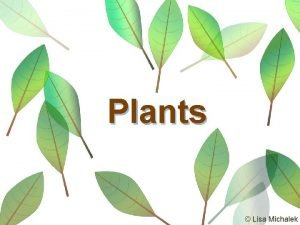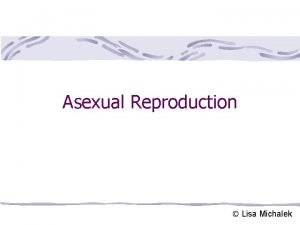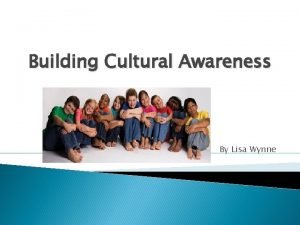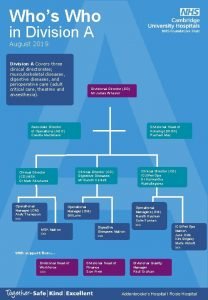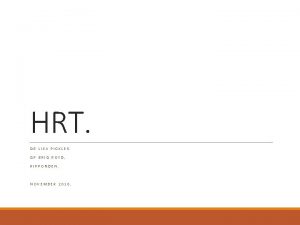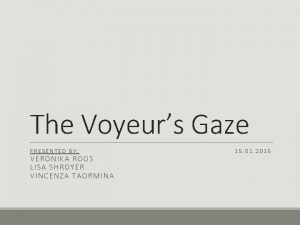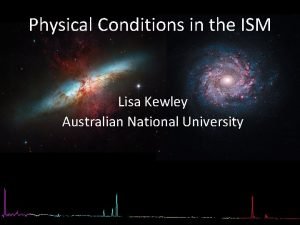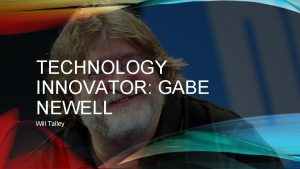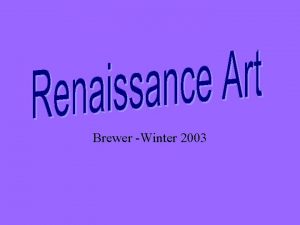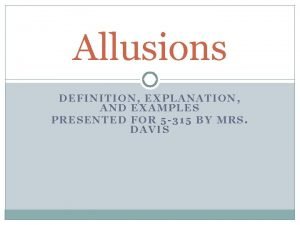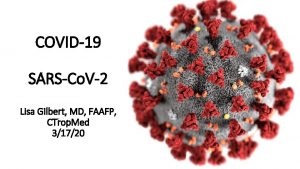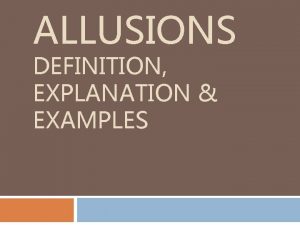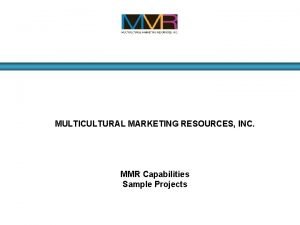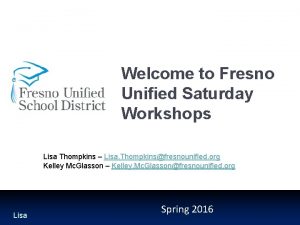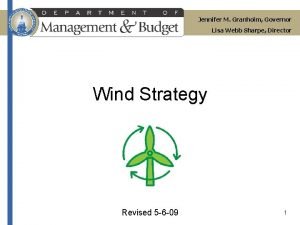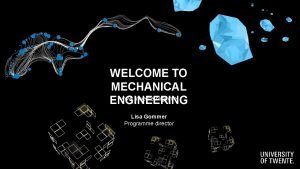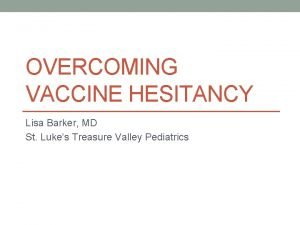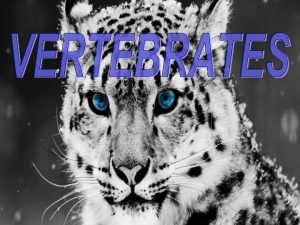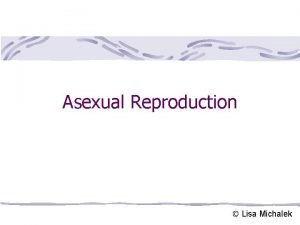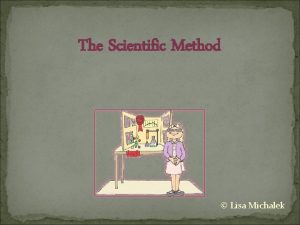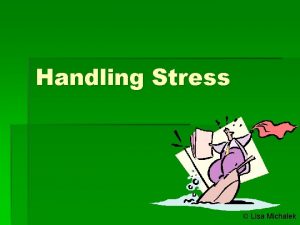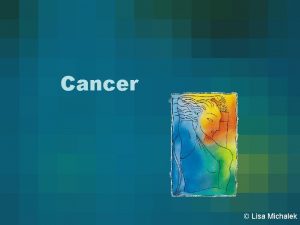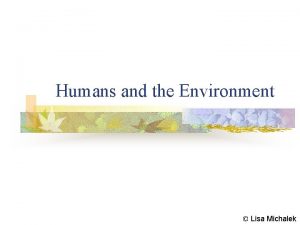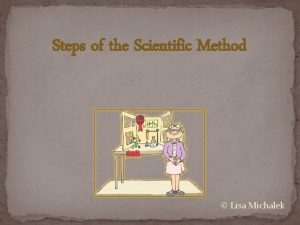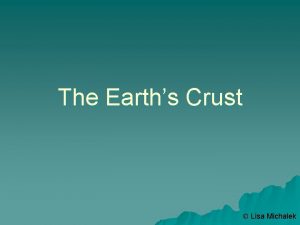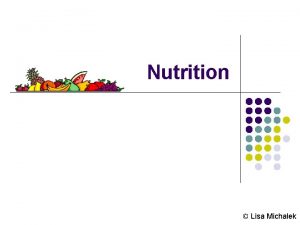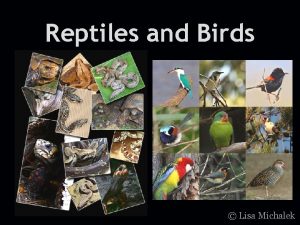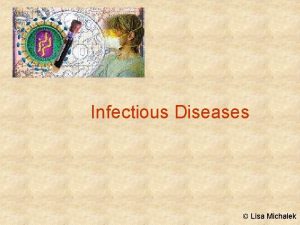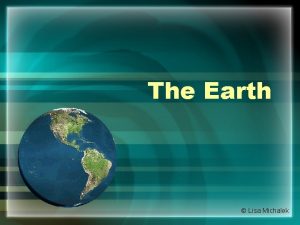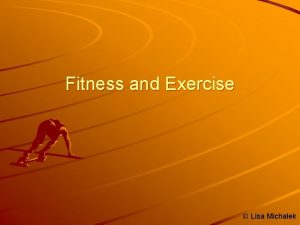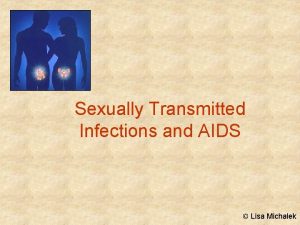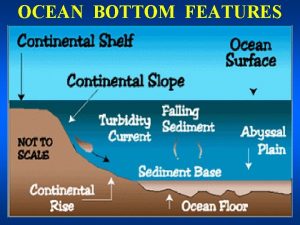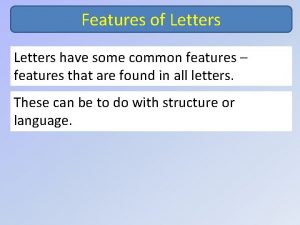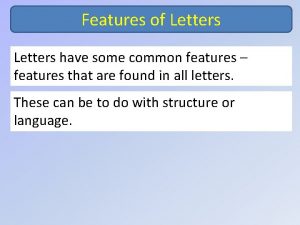Animals Lisa Michalek Features of Animals o Heterotrophy














































- Slides: 46

Animals © Lisa Michalek

Features of Animals o Heterotrophy o Animals are heterotrophs, they cannot make their own food. o Most animals move from place to place searching for food. o Once food is located, it is eaten and then digested in a cavity inside the animal’s body.

Features of Animals o Mobility o Animals are able to perform rapid, complex movements. o Animals move by means of muscle cells, specialized cells that are able to contract with considerable force. o Animals can swim, crawl, walk, run, and even fly.

Features of Animals o Multicellularity o All animals are multicellular. o Some are too small to be seen clearly with the naked eye and others are larger than a city bus. o Even though there may be differences in body size, there is little difference in the size of most of the cells that make up these animals.

Features of Animals o Diploidy o Most animals are diploid meaning that adults have two copies of each chromosome, one inherited from their father and one from their mother. o Only their gametes (egg and sperm) are haploid. o In contrast, many plants have four or more copies of each chromosome, while fungi often have only one. o An advantage of diploidy is that it permits an animal to exchange genes between the two copies of a set of chromosomes, creating new combinations of genes.

Features of Animals o Sexual Reproduction o Almost all animals reproduce sexually by producing gametes. o The female’s egg cells are much larger than the male’s sperm cells. o Unlike the egg cells, the sperm cells of animals have a flagella and are highly mobile.

Features of Animals o Absence of a Cell Wall o Among the cells of multicellular organisms, only animal cells lack rigid cell walls. o The absence of a cell wall has allowed animals mobility that other multicellular organisms do not have.

Features of Animals o Blastula Formation o In all animals (except sponges) the zygote (fertilized egg cell) undergoes, cell divisions that form a hollow ball of cells called a blastula. o Cells within the blastula eventually develop into three distinct layers of cells – ectoderm, endoderm, and mesoderm. o These layers are called the primary tissue layers because they give rise to all of the tissues and organs of the adult body.

Origin of Animal Tissues and Organs Primary Tissue Layer Gives rise to: Ectoderm Outer layer of skin; nervous system; sense organs, such as eyes Endoderm Lining of digestive tract; respiratory system; urinary bladder; digestive organs; liver; many glands Mesoderm Most of the skeleton; muscles; circulatory system; reproductive organs; excretory organs

Features of Animals o Tissues o The cells of all animals except sponges are organized into structural and functional units called tissues. o Tissues are groups of cells with a common structure that work together to perform a specific function. o The cells of muscle tissue are specialized to contract, producing movement. o The cells of nerve tissue are specialized to conduct signals.

Body Symmetry o All animals have their own particular body plan, a term used to describe an animal’s shape, symmetry, and internal organization. o An animal’s body plan results from a pattern of development programmed into the animal’s genes by natural selection. o Sponges have the simplest body plan of all animals, they are asymmetrical or irregular in shape. o Sometimes their shape depends on where they are growing. o The body plans of virtually all other animals show a definite body shape and symmetry.

Radial Symmetry o Some of the first animals to evolve in the ancient oceans had radial symmetry. o Animals with radial symmetry have body parts arranged around a central axis, somewhat like the spokes around a bicycle wheel. o A plane passing through the central axis divides the organism into roughly equal halves. o Today’s radially symmetrical animals are aquatic. o Most move slowly or drift in ocean currents.

Bilateral Symmetry o The bodies of all other animals show bilateral symmetry a body design in which there are distinct right and left halves. o A plane passing through the animal’s midline divides the animal into mirror image halves. o There is a dorsal (top) and a ventral (bottom) surface plus an anterior (front) and a posterior (back) end.

Bilateral Symmetry o Bilateral symmetry was a major evolutionary change in animals because it enabled different parts of the body to become specialized in different ways. o Most bilaterally symmetrical animals have evolved an anterior concentration of sensory structures and nerves, a process called cephalization. o Animals with cephalic ends, or heads, are often active and mobile. o With sensory organs concentrated in the front, such animals can more easily sense food and danger.

Internal Body Cavity o Bilaterally symmetrical animals have one of three basic kinds of internal body plans. o The body plan may include a body cavity or coelom (a fluid-filled space found between the body wall and the digestive tract). o Acoelomate Body Plan o Animals with no body cavity. o The space between the body wall and gut is completely filled with tissues. o Pseudocoelomate Body Plan o Animals with a body cavity located between the mesoderm and endoderm. o The body cavity is called a psudocoelom.

Internal Body Cavity o Coelomate Body Plan o Animals that have a true coelom, a body cavity located entirely within the mesoderm. o The mesodermal layer lines the body wall and wraps around the gut, the gut and other internal organs of coelomates are suspended within the coelom. o A true coelom provides an internal space where mesoderm and endoderm can be in contact with each other during embryonic development. o This aids in the evolution of complex organisms made of more than one type of tissue. o Because these internal organs are suspended in a fluid-filled coelom, they are protected from the movement of surrounding muscles. o An animal can move about without damaging the organs or interfering with their function.

Internal Body Cavity Plans

Body Segmentation o Segmented animals are composed of a series of repeating, similar units called segments. o In vertebrates, segments are not visible externally, but there is evidence of segmentation in a vertebrate embryo. o In segmented worms, each segment can move independently, permitting great flexibility and mobility. o In highly segmented animals, such as earthworms, each segment repeats many of the organs in the adjacent segment. o As a result, an injured animal can still perform vital life functions.

Body Segmentation o Materials pass from one segment to another through a circulatory system that connects them. o Nerves also connect each segment to a brain that coordinates the body’s movements.

Kinds of Animals o Kingdom Animalia contains about 35 major divisions called phyla depending on how certain organisms are classified. o The animals in the various phyla show an large range of body forms, internal body systems and behaviors. o To visually represent the relationships among various groups of animals, scientists often use a type of branching diagram called a phylogenic tree. o This shows how animals are related through evolution.

Animal Kingdom Phylogenic Tree 7 9 6 8 5 Evolutionary Milestones 1 Multicellularity 2 Tissues 3 Bilateral symmetry 4 Body cavity 5 Coelom 6 Segmentation 7 Jointed appendages 8 Deuterostomes 9 Notochord 4 3 2 1

Kinds of Animals o The animal kingdom is often divided into two groups: o Invertebrates animals without a backbone o Vertebrates animals with a backbone

Animal Body Systems o Tissues and Organs o Simple animals like sponges carry out the many tasks of living with little specialization in the cells of their body. o More complex animals have evolved tissues and organs that are specialized to perform specific functions. o Six important functions of these tissues and organs are digestion, respiration, circulation, conduction of nerve impulses, support, and excretion.

Digestion o Single-celled organisms and sponges digest their food within their body cells. o Their food source cannot be larger than their individual cells. o All other animals digest their food extracellularly (outside of their body cells) within a digestive cavity. o Digestive enzymes that are released into the cavity begin the breakdown of food, permitting the animal to prey on organisms larger than its body cells.

Digestion o Simple animals, such as the hydra and flatworms, have a gastrovascular cavity. o A digestive cavity with only one opening. o There can be no specialization within a gastrovascular cavity because every cell is exposed to all stages of food digestion.

Digestion o Other animals have a digestive tract (gut) with two openings, a mouth and an anus. o The anus is the opening through which undigested food leaves the body. o In a digestive tract, food moves in one direction, from mouth to anus. o Unlike a gastrovascular cavity, a one-way digestive system allows for specialization. o There may be a section of gut for food storage, a section for breaking down food into small pieces, and a section for the chemical digestion of food. o Eventually, the food is broken down into molecules small enough to pass through the lining of the gut and into the bloodstream.

Respiration o In simple animals, such as jellyfish, oxygen gas and carbon dioxide gas are exchanged directly with the environment by diffusion. o The uptake of oxygen and the release of carbon dioxide, called respiration, can take place only across a moist surface, such as the damp skin of an earthworm. o In larger, more complex animals, simple diffusion cannot provide for adequate gas exchange. o Most large animals have specialized respiratory structures.

Respiration o Some aquatic (and a few terrestrial) animals respire with gills, very thin projections of tissue that are rich in blood vessels. o Gills provide a large surface for gas exchange. o Gills are not suitable for most terrestrial animals because gills do not function unless they are kept moist. o A variety of respiratory organs, such as lungs, have evolved in many terrestrial animals that allow them to respire on dry land.

Circulation o In simple animals, body cells are exposed to either the external environment or the gastrovascular cavity. o None of the body cells are far away from sources of oxygen or nourishment. o More complex animals have tissues that are several cell layers thick. o Many of the cells in this tissue are not close enough to the surface of the cell layer to exchange materials directly with the environment. o Oxygen and nutrients must be transported to these body cells by a circulatory system.

Circulation o In an open circulatory system, a heart pumps fluid (hemolymph) containing oxygen and nutrients through a series of vessels out into the body cavity. o There the fluid washes across the body’s tissues, supplying them with oxygen and nutrients. o The fluid collects in open spaces in the animal’s body and flows back to the heart.

Circulation o In a closed circulatory system, a heart pumps blood through a system of blood vessels. o These blood vessels form a network that permits blood flow from the heart to all of the body’s cells and back again. o The blood remains in the vessels and does not come in direct contact with the body’s tissues. o Materials pass into and out of the blood by diffusing through the walls of the blood vessels.

Conduction of Nerve Impulses o Nerve cells (neurons) are specialized for carrying messages in the form of electrical impulses (conduction). o These cells coordinate the activities in an animal’s body, enabling the animal to sense and respond to its environment. o Members of all major animal phyla, except sponges, have nerve cells. o The simplest arrangements of nerves are found in animals like hydras and jellyfishes. o All of their nerve cells are similar and are linked to one another in a web called a nerve net. o There is little coordination among the nerve cells in a nerve net.

Nerve Net Examples Sea Anemone Jellyfish Hydra

Conduction of Nerve Impulses o Bilaterally symmetric animals have clusters of neurons called ganglia. o The ganglia at the anterior end of the animal body became larger and more complex, forming a brainlike structure, as seen in the flatworm. o More complex invertebrates, such as the grasshopper, have brains with sensory structures, such as eyes, associated with them. o These cephalized animals (animals with heads) can interact with their environment in more complex ways than other animals.

Support o An animal’s skeleton provides a framework that supports its body. o It is also vital to animal movement. o All animals move using the same force, the contraction (shortening) of muscle tissue against a framework such as the skeleton provides.

Support – Hydrostatic Skeleton o Many soft-bodied invertebrates have a hydrostatic skeleton. o Water that is contained under pressure in a closed cavity. o gastrovascular cavity or a coelom o Muscle forces exerted against the hydrostatic skeleton aid in movement.

Support - Exoskeleton o Other invertebrates (such as insects, clams and crabs) have a type of skeleton known as an exoskeleton. o A rigid external skeleton that encases the body of an animal. o The muscles of animals with exoskeletons are attached to the inside of the skeleton, which provides a surface for them to pull against. o Exoskeletons also protect an organisms soft internal parts.

Support - Endoskeleton o An endoskeleton is composed of a hard material, such as bone, embedded within an animal. o Such as humans and other vertebrates. o Muscles attached to the endoskeleton alternately contract and relax, enabling the animal to move.

Excretion o Excretion is the removal of wastes produced by cellular metabolism. o These waste products leave the cell by crossing the cell membrane and are then removed from the body. o Some waste products are highly toxic and will poison the organism if not removed. o An example harmful waste product is ammonia.

Excretion o Simple aquatic invertebrates and some fishes excrete ammonia into the water through their skin or gills by diffusion. o This is effective, but results in the loss of a lot of water. o Other animals need to minimize water loss. o One way is by converting ammonia to nontoxic chemicals, like urea. o As the excretory system eliminates these wastes, water and other useful substances are returned to the body, maintaining the body’s water balance.

Reproductive Strategies o The reproductive system of an individual animal is not essential to its survival. o However, reproduction is necessary if the species is to survive. o There are two types of reproduction in animals. o Asexual o Sexual

Asexual Reproduction o Reproduction that does not involve the fusion of two gametes is called asexual reproduction. o A sponge and starfish can reproduce by fragmenting its body (regeneration). o Each fragment grows into a new sponge/starfish. Paramecium undergoing Binary Fission Hydra Budding

Sexual Reproduction o In sexual reproduction, a new individual is formed by the union of a male and a female gamete. o Gametes are produced in the sex organs. o Testes produce the male gametes (sperm). o Ovaries produce the female gametes (eggs). o Some species of animals (slugs, earthworms and some fishes), called hermaphrodites, have both testes and ovaries. o Each individual functions as both a male and a female. o The sperm and eggs are usually produced at different times, so self-fertilization does not occur.

Sexual Reproduction o When sperm are released during sexual reproduction, their moving flagella propel them toward the egg. o Most aquatic animals release the male and female gametes near one another in the water, where external fertilization occurs. o Often large numbers of gametes are released during external fertilization, but only a small percentage of the resulting fertilized eggs will survive to develop into adults.

Sexual Reproduction o Most terrestrial animals reproduce sexually by means of internal fertilization. o The union of egg and sperm occurs within the female’s body. o The male places semen (a fluid containing sperm and fluid secretions) directly into the female’s body.

Sexual Reproduction o The eggs of terrestrial animals need protection. o Their eggs have a shell that protects them from drying out and physical damage. o Some animals place their fertilized eggs in a safe place and leave them. o Other animals remain with their eggs to protect them. o In most mammals and a few other species, the eggs develop internally, and living young emerge from their mother’s body.
 Lisa michalek
Lisa michalek Lisa michalek
Lisa michalek Chapter 32 an overview of animal diversity
Chapter 32 an overview of animal diversity G h patel college of engineering and technology
G h patel college of engineering and technology Animals that eat both plants and animals
Animals that eat both plants and animals Https://a-z-animals.com
Https://a-z-animals.com Consumers producers and decomposers
Consumers producers and decomposers Lisa wynne
Lisa wynne Pussy
Pussy Prospettive didattiche/lisa
Prospettive didattiche/lisa Wow boring
Wow boring Lisa putt addenbrookes
Lisa putt addenbrookes Lisa whittemore
Lisa whittemore Iteam the cleaning authority com
Iteam the cleaning authority com Lisa boyer skydiving accident
Lisa boyer skydiving accident Lisa pickles
Lisa pickles Veronika roos
Veronika roos Dr. lisa kewley
Dr. lisa kewley Gabe newell biography
Gabe newell biography Lisa spiro
Lisa spiro Last supper
Last supper Mona lisa rule of thirds
Mona lisa rule of thirds Lisa bohm
Lisa bohm Lisa math0
Lisa math0 Dr lisa bursill
Dr lisa bursill Freedom
Freedom Arielle silverman
Arielle silverman 5 allusions
5 allusions Lisa pace malte
Lisa pace malte Lisa gilbert md
Lisa gilbert md Robert longo
Robert longo Mona lisa allusion
Mona lisa allusion Multicultural marketing resources
Multicultural marketing resources Lisa hunter dwp
Lisa hunter dwp Lisa karsten
Lisa karsten Lisa thompkins
Lisa thompkins Whatsapp lisa
Whatsapp lisa Poor bart always chooses rock
Poor bart always chooses rock Lisa webb sharpe
Lisa webb sharpe Utwente lisa
Utwente lisa Unraavel reading strategy
Unraavel reading strategy Lisa marie chatillon
Lisa marie chatillon Dr lisa bozzoli
Dr lisa bozzoli Bloody pee
Bloody pee Dr lisa barker
Dr lisa barker Ovtes vuosisidonnainen lisä
Ovtes vuosisidonnainen lisä Lisa spectrograph
Lisa spectrograph
